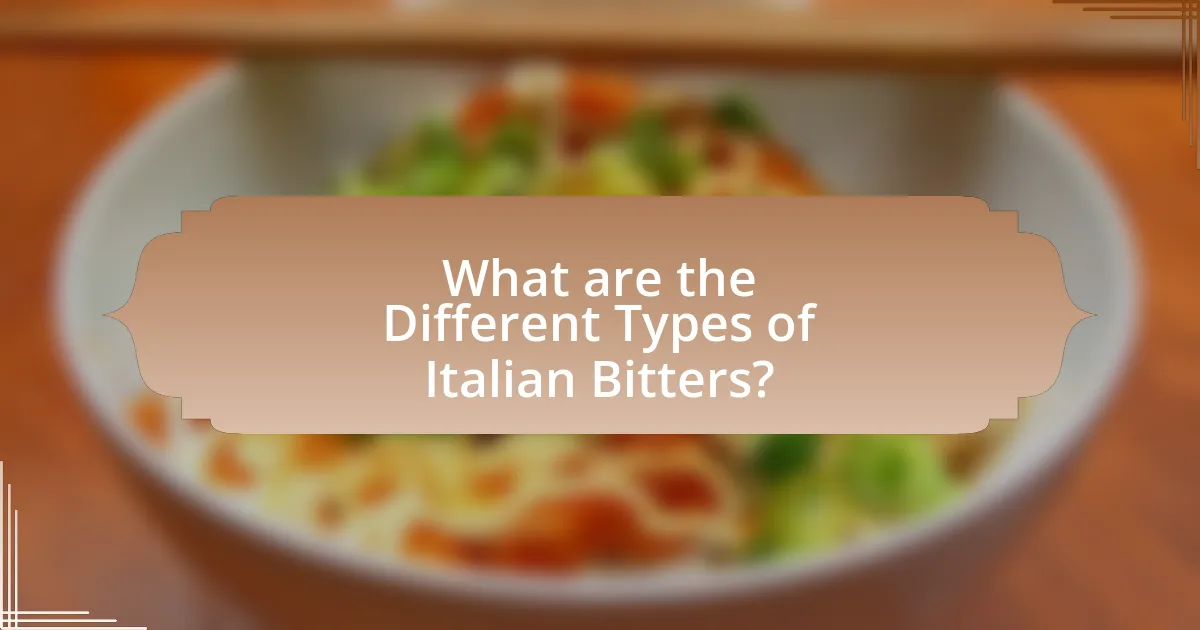Italian bitters are concentrated herbal liqueurs infused with various botanicals, playing a crucial role in enhancing the flavor of cocktails. Originating in the 18th century as medicinal tonics, they evolved into essential components of modern mixology, with brands like Campari and Aperol leading the way. The article explores the historical significance, cultural influences, and key ingredients of Italian bitters, as well as their impact on classic cocktails such as the Negroni and Americano. Additionally, it discusses the techniques for using bitters effectively in craft cocktails, common mistakes to avoid, and innovative recipes that highlight their versatility.

What are Italian Bitters and their Historical Significance?
Italian bitters are concentrated herbal liqueurs that are infused with various botanicals, including roots, herbs, and spices, primarily used to enhance the flavor of cocktails. Historically, Italian bitters emerged in the 19th century, with brands like Campari and Aperol gaining prominence, reflecting Italy’s rich tradition of herbal medicine and aperitivo culture. These bitters played a significant role in the development of classic cocktails, such as the Negroni and the Americano, and contributed to the global cocktail renaissance by introducing complex flavors and enhancing the overall drinking experience.
How did Italian Bitters originate?
Italian bitters originated in the 18th century in Italy, primarily as medicinal tonics made from various herbs and spices. These concoctions were initially created by apothecaries who aimed to provide digestive aids and remedies for ailments. The popularity of these bitters grew, leading to the development of distinct brands, such as Campari and Aperol, which emerged in the 19th century and began to be used in cocktails. The use of Italian bitters in mixology became prominent as bartenders recognized their ability to enhance flavors and balance drinks, solidifying their role in the craft cocktail movement.
What cultural influences shaped the development of Italian Bitters?
Italian Bitters were shaped by a combination of ancient herbal traditions, regional agricultural practices, and social customs in Italy. The use of herbs and spices in medicinal concoctions dates back to Roman times, where they were believed to aid digestion and health. This practice evolved in the 19th century with the rise of aperitifs, particularly in regions like Piedmont and Veneto, where local botanicals were incorporated into bitters recipes. The cultural significance of communal drinking and social gatherings further influenced the development of these beverages, as they became integral to Italian dining and hospitality traditions. The establishment of brands like Campari and Aperol in the late 1800s solidified the role of bitters in Italian culture, emphasizing their use in cocktails and aperitifs, which are now staples in both Italian and global drinking culture.
How have Italian Bitters evolved over time?
Italian Bitters have evolved from traditional herbal concoctions used for medicinal purposes in the 18th century to essential components in modern craft cocktails. Initially, these bitters were created by apothecaries and featured a variety of botanicals aimed at aiding digestion and overall health. Over time, particularly in the 19th century, the production of Italian Bitters transitioned to commercial distilleries, leading to the development of iconic brands like Campari and Aperol, which introduced sweeter profiles and vibrant colors. This evolution reflects a shift in consumer preferences towards flavor complexity and mixability, solidifying Italian Bitters’ role as a staple in contemporary cocktail culture.
What are the key ingredients in Italian Bitters?
The key ingredients in Italian Bitters typically include a blend of aromatic herbs, spices, and citrus peels. Common components are gentian root, which provides bitterness, along with other botanicals such as cinchona bark, orange peel, and various herbs like wormwood and anise. These ingredients are macerated in alcohol to extract their flavors, resulting in a complex and aromatic profile that enhances cocktails. The use of these specific botanicals is rooted in traditional recipes that date back to the 19th century, reflecting the historical significance of Italian Bitters in the cocktail culture.
Which herbs and spices are commonly used in Italian Bitters?
Italian bitters commonly include herbs and spices such as gentian, wormwood, orange peel, and various aromatic herbs like anise and coriander. Gentian root is particularly significant as it provides the characteristic bitterness, while wormwood adds complexity. Orange peel contributes citrus notes, enhancing the overall flavor profile. These ingredients are traditionally used in the production of Italian bitters, which are integral to many classic cocktails, underscoring their importance in mixology.
How do these ingredients contribute to the flavor profile?
Italian bitters contribute to the flavor profile of craft cocktails by adding complexity, depth, and balance. These ingredients typically include a blend of herbs, spices, and citrus, which enhance the overall taste experience. For instance, the bitterness from ingredients like gentian root provides a counterpoint to sweetness, while aromatic components such as orange peel introduce bright, zesty notes. This combination creates a multi-dimensional flavor that can elevate a cocktail, making it more intriguing and enjoyable. The use of Italian bitters is supported by their historical significance in cocktail culture, where they have been integral in crafting balanced drinks since the 19th century.
Why are Italian Bitters essential in craft cocktails?
Italian Bitters are essential in craft cocktails because they provide complex flavors and enhance the overall taste profile of the drink. These bitters, often made from a blend of herbs, spices, and botanicals, contribute depth and balance, making cocktails more intriguing and enjoyable. For instance, classic cocktails like the Negroni and the Manhattan rely on Italian Bitters to achieve their signature taste, showcasing their importance in cocktail recipes. The use of bitters can also stimulate the palate, making them a crucial component in the art of mixology.
What role do Italian Bitters play in balancing flavors?
Italian Bitters play a crucial role in balancing flavors by adding complexity and depth to cocktails. These bitters contain a blend of herbs, spices, and botanicals that enhance the overall taste profile, counteracting sweetness and acidity. For instance, the bitterness from ingredients like gentian root or wormwood can temper overly sweet components, creating a more harmonious drink. This balancing act is essential in cocktail crafting, as it allows for a well-rounded flavor experience, making drinks more enjoyable and sophisticated.
How do Italian Bitters enhance the overall cocktail experience?
Italian Bitters enhance the overall cocktail experience by adding complexity and depth to flavors. These bitters, often infused with a variety of herbs, spices, and botanicals, create a balance between sweetness and bitterness, which is essential for a well-rounded cocktail. For instance, the use of Italian Bitters like Aperol or Campari can elevate a simple drink by introducing aromatic notes and enhancing the palate’s perception of other ingredients. This is supported by the fact that cocktails featuring bitters are often more enjoyable, as they stimulate the taste buds and promote a richer sensory experience.

What are the Different Types of Italian Bitters?
Italian bitters can be categorized into several distinct types, primarily including Amaro, Aperitivo, and Digestivo. Amaro is a herbal liqueur that is typically bitter and often consumed after meals to aid digestion; examples include Fernet-Branca and Averna. Aperitivo is lighter and usually enjoyed before meals to stimulate appetite, with popular varieties being Campari and Aperol. Digestivo, while also a type of Amaro, is specifically designed for post-meal consumption, with options like Amaro Montenegro and Ramazzotti. Each type serves a unique role in cocktails, enhancing flavors and providing balance.
How do various Italian Bitters differ in flavor and use?
Italian bitters differ significantly in flavor and use, primarily due to their unique botanical blends and intended applications in cocktails. For example, Aperol is known for its sweet, citrusy flavor profile with a lower alcohol content, making it ideal for refreshing spritz cocktails. In contrast, Campari offers a more bitter and herbal taste, often used in classic cocktails like the Negroni, where its bold flavor complements the other ingredients. Fernet-Branca, characterized by its intense bitterness and complex herbal notes, is frequently consumed as a digestif or used in cocktails that require a strong flavor backbone. Each type of Italian bitter serves distinct purposes in mixology, influencing the overall taste and character of the drinks they are used in.
What are the characteristics of popular Italian Bitters brands?
Popular Italian Bitters brands are characterized by their complex flavor profiles, high-quality ingredients, and traditional production methods. These brands often feature a blend of herbs, spices, and citrus, creating a balance of bitterness and aromatic qualities that enhance cocktails. For instance, brands like Campari and Aperol are known for their vibrant red color and distinct herbal notes, while Fernet-Branca is recognized for its intense bitterness and unique blend of 27 herbs. The use of natural ingredients and artisanal techniques in their production contributes to their authenticity and appeal in the craft cocktail scene.
How can bartenders choose the right Italian Bitters for their cocktails?
Bartenders can choose the right Italian Bitters for their cocktails by considering the flavor profile of the cocktail and the specific characteristics of the bitters. Each type of Italian Bitter, such as Aperol, Campari, or Fernet, has distinct flavor notes ranging from sweet and citrusy to herbal and bitter. For example, Campari is known for its strong bitter flavor and is often used in Negronis, while Aperol offers a lighter, sweeter profile suitable for spritz cocktails. Additionally, bartenders should evaluate the balance of flavors in their cocktails; the chosen bitters should complement or enhance the primary ingredients without overpowering them. This approach is supported by the fact that the right bitters can elevate a cocktail’s complexity and depth, as evidenced by the popularity of classic cocktails that rely on specific bitters for their signature taste.
What are some classic cocktails that feature Italian Bitters?
Classic cocktails that feature Italian Bitters include the Negroni, the Americano, and the Boulevardier. The Negroni is a well-known cocktail made with equal parts gin, sweet vermouth, and Campari, an Italian bitter. The Americano combines Campari with sweet vermouth and soda water, creating a refreshing drink. The Boulevardier is a whiskey-based variation of the Negroni, using bourbon or rye whiskey instead of gin, along with sweet vermouth and Campari. These cocktails highlight the distinctive flavor profile of Italian Bitters, which adds complexity and depth to the drinks.
How do Italian Bitters transform traditional cocktail recipes?
Italian Bitters transform traditional cocktail recipes by adding complexity and depth through their unique blend of herbs, spices, and botanicals. These bitters enhance flavor profiles, balancing sweetness and acidity, which is essential in classic cocktails like the Negroni or the Manhattan. For instance, the use of Campari or Aperol introduces a bitter note that contrasts with the sweetness of vermouth, creating a more nuanced drinking experience. Historical context shows that Italian Bitters have been integral to cocktail culture since the late 19th century, influencing the evolution of mixology and leading to the resurgence of craft cocktails today.
What are the most popular cocktails that highlight Italian Bitters?
The most popular cocktails that highlight Italian Bitters include the Negroni, the Americano, and the Boulevardier. The Negroni, made with equal parts gin, sweet vermouth, and Campari, showcases the bitters’ herbal complexity. The Americano, consisting of Campari, sweet vermouth, and soda water, emphasizes the bitters’ refreshing qualities. The Boulevardier, a whiskey-based variation of the Negroni, combines bourbon or rye with sweet vermouth and Campari, highlighting the bitters’ rich flavor profile. These cocktails are widely recognized for their distinctive use of Italian Bitters, particularly Campari and Aperol, which are integral to their taste and character.

How to Use Italian Bitters in Craft Cocktails?
To use Italian bitters in craft cocktails, incorporate them as a flavor enhancer, typically in small dashes or drops. Italian bitters, such as Aperol or Campari, add complexity and depth to cocktails by balancing sweetness and bitterness. For example, in a Negroni, equal parts gin, sweet vermouth, and Campari create a well-rounded drink, showcasing the bitters’ role in enhancing the overall flavor profile. The use of Italian bitters is rooted in their historical significance in cocktail culture, where they have been utilized since the 19th century to elevate drinks through their aromatic qualities.
What techniques can enhance the use of Italian Bitters in cocktails?
To enhance the use of Italian Bitters in cocktails, bartenders can employ techniques such as layering flavors, using bitters as a rinse, and incorporating them into syrups or infusions. Layering flavors involves adding bitters at different stages of cocktail preparation to create depth; for example, using a few dashes in the mixing glass and another dash as a garnish. Utilizing bitters as a rinse, where a glass is coated with bitters before adding the cocktail, can impart a subtle aroma and flavor without overwhelming the drink. Additionally, creating flavored syrups or infusions that include Italian Bitters allows for a more integrated flavor profile, enhancing the overall complexity of the cocktail. These techniques are supported by the fact that bitters are concentrated flavor agents, and their strategic use can significantly elevate the taste experience in craft cocktails.
How can bartenders experiment with Italian Bitters in their creations?
Bartenders can experiment with Italian Bitters by incorporating them into various cocktail recipes, adjusting the quantity to enhance flavor profiles. For instance, using a few dashes of Italian Bitters in classic cocktails like the Negroni or Manhattan can add complexity and depth, as these bitters are known for their herbal and aromatic qualities. Additionally, bartenders can create unique signature cocktails by blending Italian Bitters with different spirits, such as gin or whiskey, and pairing them with complementary ingredients like citrus or sweet vermouth. This experimentation is supported by the fact that Italian Bitters have a long history in cocktail culture, dating back to the 19th century, which highlights their versatility and importance in mixology.
What are some common mistakes to avoid when using Italian Bitters?
Common mistakes to avoid when using Italian Bitters include overusing the product, which can overwhelm the cocktail’s flavor profile, and neglecting to balance the bitters with other ingredients. Additionally, failing to consider the specific type of Italian Bitters can lead to mismatched flavors; for example, using a sweet bitter in a drink that requires a more herbal or bitter profile can result in an unbalanced cocktail. Lastly, not properly chilling the cocktail can diminish the intended taste experience, as Italian Bitters are often best enjoyed in a well-chilled drink.
What are the best practices for storing and serving Italian Bitters?
The best practices for storing and serving Italian Bitters include keeping them in a cool, dark place and using them within a year of opening for optimal flavor. Italian Bitters should be stored upright to prevent leakage and oxidation, which can degrade their quality. When serving, it is essential to use a few dashes to enhance cocktails without overpowering them, as their concentrated flavors can significantly impact the drink’s balance. Additionally, using a jigger for precise measurements ensures consistency in cocktails. These practices help maintain the integrity and flavor profile of Italian Bitters, which are crucial for crafting high-quality cocktails.
How should Italian Bitters be stored to maintain their quality?
Italian Bitters should be stored in a cool, dark place to maintain their quality. Exposure to light and heat can degrade the flavors and aromas of the bitters, leading to a diminished taste profile. It is also advisable to keep the bottle tightly sealed to prevent oxidation, which can alter the bitters’ characteristics over time. Storing Italian Bitters upright helps to minimize contact with the cork, reducing the risk of cork taint. These storage practices ensure that the bitters retain their intended flavor and aromatic qualities for an extended period.
What serving tips can enhance the enjoyment of cocktails with Italian Bitters?
To enhance the enjoyment of cocktails with Italian Bitters, serve them chilled and in appropriate glassware, such as a coupe or rocks glass, to elevate the drinking experience. Chilling the cocktail allows the complex flavors of the bitters to be more pronounced, while the right glassware can enhance aroma and presentation. Additionally, incorporating fresh citrus garnishes, like an orange twist or lemon peel, can complement the bitters’ herbal notes and add visual appeal. Research indicates that the sensory experience of cocktails is significantly influenced by temperature and presentation, which supports the effectiveness of these serving tips.
What are some innovative cocktail recipes featuring Italian Bitters?
Innovative cocktail recipes featuring Italian Bitters include the “Bitter Negroni,” which combines equal parts gin, sweet vermouth, and Italian bitters, garnished with an orange twist. Another example is the “Italian Spritz,” made with prosecco, Italian bitters, and soda water, served over ice with an orange slice. Additionally, the “Bittered Sling” features Italian bitters, rye whiskey, and a splash of ginger beer, garnished with a lemon peel. These recipes highlight the versatility of Italian bitters in enhancing flavors and adding complexity to cocktails.
How can unique flavor combinations be achieved with Italian Bitters?
Unique flavor combinations with Italian Bitters can be achieved by blending various bitters with complementary ingredients, such as spirits, citrus, and sweeteners. Italian Bitters, known for their complex herbal and aromatic profiles, can enhance cocktails when paired with contrasting flavors like sweet vermouth or fresh citrus juices. For instance, combining an orange-flavored Italian Bitter with gin and tonic water creates a refreshing drink that balances bitterness with sweetness and acidity. Additionally, experimenting with different ratios and incorporating ingredients like fresh herbs or spices can further diversify flavor profiles, allowing for a wide range of unique cocktail experiences.
What are some seasonal cocktails that utilize Italian Bitters effectively?
Seasonal cocktails that effectively utilize Italian Bitters include the Negroni, which combines equal parts gin, sweet vermouth, and Campari, a type of Italian Bitter, making it a popular choice in spring and summer. Another example is the Boulevardier, a whiskey-based cocktail that substitutes bourbon for gin in the Negroni, offering a warming option for fall and winter. Additionally, the Spritz, made with Prosecco, soda water, and Aperol or Campari, is a refreshing summer drink that highlights the bitters’ citrus notes. These cocktails showcase the versatility of Italian Bitters across different seasons, enhancing flavors and providing a unique taste experience.










